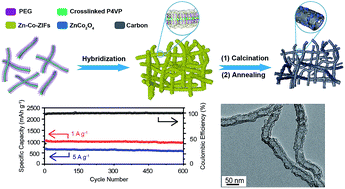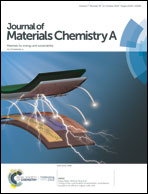A network of porous carbon/ZnCo2O4 nanotubes derived from shell-hybridized worm-like micelles for lithium storage†
Abstract
In this work, hybrid carbon/ZnxCo3−xO4 (ZCO) nanotube (HCNT) networks have been efficiently prepared, using highly pure, uniform and long core-crosslinked polymeric worm-like micelles (PWs) with a small diameter and a 3D interacting shell as the 1D template. The HCNTs have a diameter of 50 nm, a channel of 30 nm width, and a hybrid porous wall in which large amounts of open micropores (ca. 5 nm) and ZCO nanoparticles (NPs, <5 nm) are uniformly distributed. The network is formed by closely stacked HCNTs and has a high specific interfacial area (up to 825 m2 g−1) and open hierarchical pores. When used for lithium storage, the anode prepared from the network has excellent electrochemical performance including high capacity (up to 1124 mA h g−1 at 1 A g−1), good rate performance and excellent cycling stability (90% capacity remains after 600 cycles at 1 A g−1). For the preparation of the networks, the abovementioned PWs with PEG as the shell and a width of 28 nm can be efficiently prepared. During hybridization, the strong 3D interaction between the PEG chains and Zn2+/Co2+ inhibited the zeolitic imidazolate frameworks (ZIFs) to form individual crystalline particles of intrinsic size and shape. Instead, the ZIF crystals deformed and fused together to form a uniform hybrid layer, ca. 30 nm thickness, in which the PEG chains penetrated into the crystalline structure of ZIFs. In the layer, Zn and Co were homogeneously mixed and the Co/Zn ratio was conveniently adjusted. When the Co/Zn ratio was 2, the hierarchically porous network of carbon/ZnCo2O4 nanotubes with excellent electrochemical performance was finally obtained.



 Please wait while we load your content...
Please wait while we load your content...